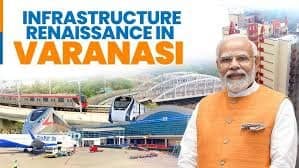
Varanasi, one of the world’s oldest cities, is more than just a spiritual and cultural gem—it’s quickly becoming an economic powerhouse in India. Over the past decade, the city has seen a remarkable transformation. Thanks to government efforts, new infrastructure, and a booming local economy, Varanasi is well on its way to becoming one of the country’s future economic leaders. Let’s take a closer look at how this ancient city is paving its way to the future:
1. Booming Infrastructure
A huge part of Varanasi’s economic success can be credited to massive infrastructure investments. The government has pumped resources into improving everything from roads to railways to air connectivity. The Kashi Vishwanath Corridor, for example, has linked the iconic Kashi Vishwanath Temple to the Ganges River, boosting tourism and drawing investments into hospitality and retail. Even the city’s railway station is getting a makeover to handle the increasing number of travelers, making Varanasi an even more important transport hub.
2. Tourism Surge
Known for its religious significance, Varanasi is now also drawing a growing number of tourists, both from India and abroad. This influx has spurred the growth of new hotels, restaurants, and services. While people come for the spiritual experience, they’re also exploring the city’s rich history and heritage, which has boosted the tourism industry and created a wave of investment in the hospitality sector.
3. The Craft Renaissance
Varanasi is famous for its Banarasi silk sarees, and today, the city’s textile industry is more vibrant than ever. With initiatives like the “One District, One Product” scheme, traditional crafts have received new attention, and demand for Banarasi silks is booming. These efforts are not only preserving local art forms but also providing jobs to thousands of artisans, keeping the craft alive while benefiting the local economy.
4. Education & Research Hub
Varanasi is emerging as a key educational and research center in India. The Banaras Hindu University (BHU), one of the country’s most prestigious universities, continues to attract students from all over. Along with BHU, many new educational institutions are being set up, making the city a hub for academic and research-based industries. The growing student population is fueling both innovation and a workforce that’s highly skilled and ready to meet the needs of a modern economy.
5. Real Estate Growth
With infrastructure development and a rising number of tourists and businesses, Varanasi’s real estate market is booming. From new commercial spaces to residential projects, there’s a growing demand for housing and office spaces. As the city becomes more urbanized and business districts expand, it’s clear that Varanasi’s real estate sector is set to keep thriving.
6. Startups and Innovation
Varanasi is also tapping into the startup ecosystem, with several tech and non-tech ventures sprouting up. Supported by initiatives like Startup India, these startups are capitalizing on the city’s growing infrastructure and talented workforce. With a focus on sectors like e-commerce, education, agriculture, and tourism, these startups are contributing to a more diverse local economy and positioning Varanasi as an entrepreneurial hub.
7. Logistics and Manufacturing
Strategically located at the intersection of major transportation routes, Varanasi has become a vital player in the logistics sector. The Ganga Expressway, national highways, and modernized airport make it an attractive location for businesses to set up warehouses and distribution centers. In addition to logistics, the manufacturing sector—especially ceramics, metalworks, and handlooms—is thriving, further contributing to the city’s economic momentum.
8. Political Backing and Government Focus
Varanasi has attracted significant attention from the political leadership, particularly from Prime Minister Narendra Modi, who represents the city in Parliament. The government has consistently focused on developing Varanasi, ensuring it gets the support it needs for growth. From infrastructure upgrades to promoting cultural preservation and job creation, Varanasi is receiving both state and central backing, which further solidifies its position as an economic powerhouse.
9. Smart City and Sustainability
Growth isn’t just about expansion—it’s about sustainability. As part of the Smart Cities Mission, Varanasi is working on projects that incorporate technology and environmental responsibility. From solar power and smart traffic management to waste-to-energy and sustainable water practices, the city is focusing on eco-friendly development, ensuring its progress is as green as it is forward-thinking.
Conclusion: The Future is Bright
Varanasi’s economic rise is thanks to a balanced approach that merges traditional industries with modern developments. With a solid foundation in tourism, education, manufacturing, and technology, the city is on its way to becoming a major economic player in India. As more investments pour in, Varanasi’s future looks incredibly bright. The combination of old-world charm and new-world opportunities makes this city a perfect example of how tradition and innovation can coexist to drive growth.





